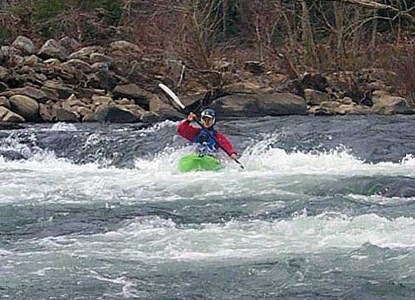
The Obed Wild and Scenic River features spectacular whitewater streams that draw seasoned paddlers from all parts of the Eastern United States. Unfortunately, if you have limited experience with whitewater paddling, you have quite a bit of homework to do before you will be ready to negotiate the park's streams safely. Click here for paddling tips. Potentially lethal hazards abound on all sections of the park's streams. Undercut rocks and rocks piled together to form "sieves" rank near the top of this list, as do fallen trees or "strainers." You will frequently find these positioned immediately below difficult rapids, and if you find yourself out of your boat, there is a chance that you may be washed into and under one of these features with incredible force. The water will pass on through the obstacle but your body may not. Foot entrapment can occur in any location in swiftly moving water. Do not attempt to stand up in strong current if the water is more than knee deep. Escape from recirculating "holes" or "hydraulics" can be difficult or impossible, and the water in these hydraulics is frequently so aerated that a swimmer who is stuck in one will only occasionally make his way to the surface for a breath of air. 
Cold presents another very real threat to your safety. The water is cold almost year round and waves will be continually breaking over you and your boat as you attempt to navigate the park's streams. Hypothermia can occur on surprisingly mild days, especially if you find yourself swimming repeatedly. The park's rivers can rise dramatically and without warning. When you see gigantic logs balanced precariously on top of house-sized, midstream boulders, know that those trees floated to their lofty perch. It is not uncommon for the river to come up twenty feet in bigger floods, and in the flood of 1929 it rose to forty feet above its summer levels, overtopping the road surface of the old bridge at Nemo. Waves can build to heights of over ten feet. At such times the river moves with such heart-stopping speed that it can be almost impossible to escape from the river if you are unfortunate enough to find yourself out of your boat. The rate of rise can also be astounding, with stream levels climbing several feet in an hour and radically changing the character of the river. And if you are thinking that maybe you will wait until times of very low flow to take a float trip, you should know that the Obed's rangers perform more searches and rescues at times of low flow than they do at any other water level. Although the view from the bridges can be deceptive, even the handful of river sections within the park that are given a "Class II" rating are not suitable for beginners, as they still feature technical rapids that require precise maneuvering and that may possess all the hazards mentioned above. Again, rangers perform more rescues on these "easier" sections than they do on the more daunting reaches of river. There is good news, however. Experienced paddlers regularly float our streams (and streams that are much, much more challenging) without incident and with time and experience you'll be able to join them. Whitewater paddling clubs-the East Tennessee Whitewater Club, the Chota Canoe Club, and the Tennessee Scenic Rivers Association, for example-are great places to receive training and to connect with experienced paddlers. Moving water will always be dangerous and there is an element of unpredictability that will never be completely eliminated from whitewater paddling. With the proper training and equipment, however, you can mitigate those risks to such an extent that the most dangerous part of some river trips may well be the drive to the put-in. We hope to see you on the river soon! |
Last updated: May 20, 2015
